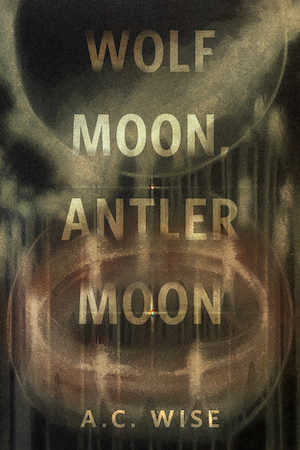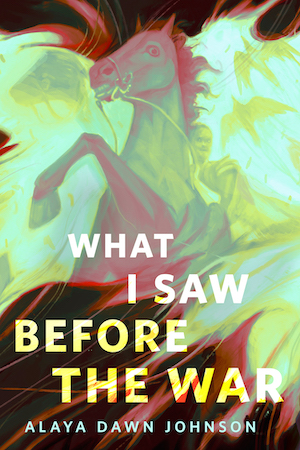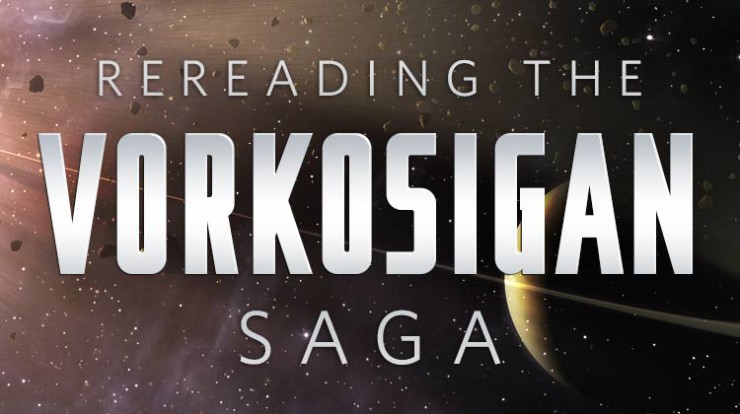My first encounter with Lois McMaster Bujold was The Warrior’s Apprentice, which I read for the first time shortly before starting high school. As a young reader, my imagination was caught by Miles’ tenacity. But this is a universe much richer than the wild adventures of one small admiral could ever show. The Vorkosigan Saga now spans 16 novels and assorted short stories and novellas that hop between genres from space opera, to mystery, to romance. It spans ten planets and an asteroid belt (at least—I’m counting on my fingers, I might have missed a few). The common thread tying these stories together is biology. Biology happens at both an individual and a population level, and so does the Vorkosigan Saga. The stories that happen to Bujold’s characters often have impacts on the planetary and interplanetary level, and vice versa.
The longer the Vorkosigan Saga has gone on, the more reasons I have found to love it. I’m not alone—Lois McMaster Bujold has won more Hugo Awards for best novel than anyone but Robert Heinlein, three of them for novels in this series. I’m thrilled to be rereading it.
I will be tackling the books in internal chronological order, with the exception of the stories that were published together in Borders of Infinity, which will get lumped together with their frame story after Brothers in Arms. Each week I will summarize a section of a book, followed by analysis and commentary.
The series has been around for thirty years, so I’m going to be quite free with the spoilers for most volumes. However, spoilers for Gentleman Jole and the Red Queen (which I reviewed here) should be reserved until after Jole makes his first appearance in The Vor Game. That’s five books away, so readers who want to avoid being spoiled have a few months to get caught up.
Many science fiction series have an iconic look to their covers, something that allows readers to look at a shelf from across the bookstore and see that their favorite series has a new volume. George R.R. Martin’s A Game of Thrones is one great example. John Harris’ covers for John Scalzi’s Old Man’s War series are another. The Vorkosigan Saga is not one of these. Over the years, these books have been published under a motley collection of covers. As we start each book, I will comment on a selection of these.
So let’s get started!
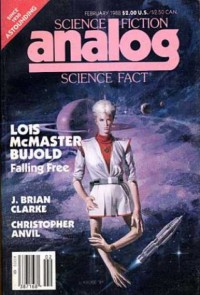 Falling Free was originally published in 1988. It was the third book to be published in the Vorkosigan Saga, after Warrior’s Apprentice and Shards of Honor, but it is set centuries before those. Falling Free was serialized in Analog Magazine before it was as a novel, and won a Nebula Award.
Falling Free was originally published in 1988. It was the third book to be published in the Vorkosigan Saga, after Warrior’s Apprentice and Shards of Honor, but it is set centuries before those. Falling Free was serialized in Analog Magazine before it was as a novel, and won a Nebula Award.
The Analog cover features a Quaddie, one of the book’s race of four-armed people who work in zero-gravity. I think this is probably Silver, the Quaddie protagonist. Quaddies usually wear shorts and t-shirts, which is practical for people who have four legs. The story does not mention shoulder pads or power suits. This picture also highlights a problem I have with Quaddie representation—their lower arms and hands always look weird. There’s a marked contrast between the upper hands in this image, which look like normal hands, and the lower hands, which are straight out of the Uncanny Valley.
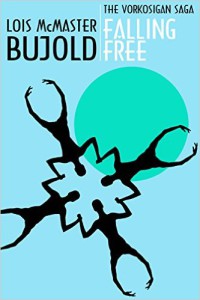 This problem is also notable in the recent ebook cover (seen at right). The musculature in the Quaddies’ lower arms makes them look weirdly multi-jointed. Their bowlegged appearance is true to the description in the book. Although their lower arms remind me of crawfish claws, I love the abstract silhouette of the four Quaddies holding hands as a symbol of the communal nature of Quaddie culture.
This problem is also notable in the recent ebook cover (seen at right). The musculature in the Quaddies’ lower arms makes them look weirdly multi-jointed. Their bowlegged appearance is true to the description in the book. Although their lower arms remind me of crawfish claws, I love the abstract silhouette of the four Quaddies holding hands as a symbol of the communal nature of Quaddie culture.
Some illustrators have dealt with lower arm issue by obscuring the area between waist and lower elbow. The Baen cover to the right is one example of the “Surprise bonus hands!” school of Quaddie representation.
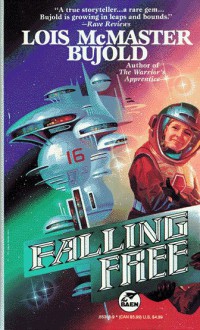 I’m not a fan—it reduces the Quaddies to one feature and perpetuates their exploitation.
I’m not a fan—it reduces the Quaddies to one feature and perpetuates their exploitation.
The 2004 NESFA Press cover (below, right) also conceals hips, but it offers a lot of arms. Here, Silver clings to engineer Leo Graf’s back, with their arms intertwined. Silver’s clothing looks more utilitarian, and her hair has been updated. Her lower hands suggest that zero-gravity space work causes significant physical strain. They also emphasize Silver’s strength. This cover is my favorite of the lot.
Falling Free, Chapter 1
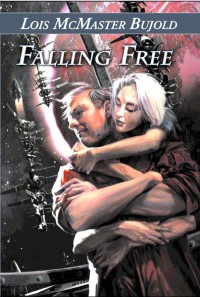 Leo Graf, engineer and welding instructor, arrives at his new job on the Cay Project. His new boss, Bruce Van Atta, greets him at the the space station in orbit around the planet Rodeo. Van Atta is an ambitious administrator who’s excited about making the Cay Project profitable. He seems to know Leo from somewhere, but Leo can’t place him. It’s clear that Leo doesn’t know the details of the Cay Project, and Van Atta is excited to see how he reacts when he finds out. They take a private shuttle to the orbital habitat where Leo will be working. Leo notices that it’s big enough to support about 1500 people, and has no rotating section—and thus, no artificial gravity. Van Atta brags about the associated cost savings.
Leo Graf, engineer and welding instructor, arrives at his new job on the Cay Project. His new boss, Bruce Van Atta, greets him at the the space station in orbit around the planet Rodeo. Van Atta is an ambitious administrator who’s excited about making the Cay Project profitable. He seems to know Leo from somewhere, but Leo can’t place him. It’s clear that Leo doesn’t know the details of the Cay Project, and Van Atta is excited to see how he reacts when he finds out. They take a private shuttle to the orbital habitat where Leo will be working. Leo notices that it’s big enough to support about 1500 people, and has no rotating section—and thus, no artificial gravity. Van Atta brags about the associated cost savings.
Leo likes zero-G: it makes him feel athletic. When he gets off the shuttle, Van Atta introduces him to one of his future students, Tony, who has four hands. Tony also has a designation number, rather than a name. Leo doesn’t seem to notice this, but he is intrigued by Tony’s “birth defect,” and by the ingenuity of whoever decided to find Tony a job in zero-G. Van Atta explains that Tony is one of the 1,000 permanent inhabitants of the station. The extra arms (and missing legs) aren’t a birth defect. Leo notices several groups of Quaddies as they float through the station. They all seem disturbingly young.
On the way to Leo’s quarters, Tony suggests a stop in hydroponics. He introduces Leo to his partner, Claire and their baby, Andy. Claire is one of the first “natural mothers” among the Quaddies. She used to be a welder like Tony, but now works inside so she can combine work and infant care. Tony also introduces Claire’s co-worker, Silver. Van Atta calls her Sugarplum.
The Quaddies were genetically engineered to function in zero-G environments. They also have superior bone density, resistance to radiation, and a series of other improvements that make them a superior deep space work force. Their genetic material was drawn from hundreds of sources, and the first thousand members of them were gestated in uterine replicators, invented on Beta Colony. Leo has heard of these being used in obstetric emergencies. Van Atta says the only reason they aren’t more common is the cost. The Quaddies, however, are in the process of becoming “self-replicating” —another cost savings. Anti-mutant sentiment drove the Cay Project to seek a friendly legal climate in the remoter reaches of space. Leo asks what the Quaddies are paid, and Van Atta informs him that they aren’t Galactech employees—they’re capital equipment.
Commentary
In a chapter full of exposition, the most important revelation is the far-future reinvention of slavery. Tony and Claire seem happy, and their baby is an adorable reminder that the Quaddies are being bred as a self-perpetuating slave labor force. Van Atta calls them chimps. Leo is alarmed, but hasn’t done more than ask a few slightly-pointed questions. He’s allowed himself to be distracted by engineering challenges and teaching plans. I don’t know what I expect him to do, but I’m angry with him for not doing it right away.
The scene in the hydroponics lab also introduces Silver, who seems oddly sexualized. She’s wearing pink nail polish and she seems to want Van Atta’s attention, even though she converses with him upside down. She seems shallow, but her actions later in the book make me think this is a tiny act of rebellion.
Other than the Quaddies themselves, the major biological innovation here is the uterine replicator. Van Atta describes them as a clean, controlled engineering approach. To producing capital equipment. Once he’s done extolling the ways in which uterine replicators facilitate Galactech’s crimes against humanity, Van Atta implies that women have a biological duty to bear children. Van Atta is a Platonic villain. Literature has many villains more villainous than this, but additional villainy is surplus to requirements.
Leo’s major interests are quality control and failure analysis, an interest he shares with Auditor Vorthys, and possibly with Bujold’s father, the author of the Nondestructive Testing Handbook.
Tune in next week for Chapters 2-3!
Ellen Cheeseman-Meyer teaches history and reads a lot.




